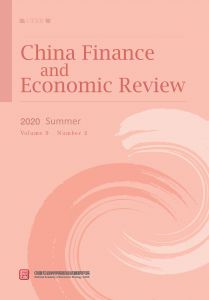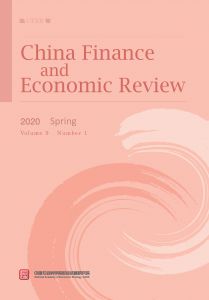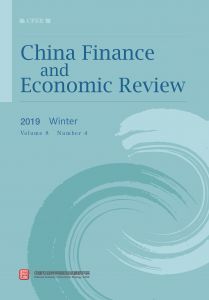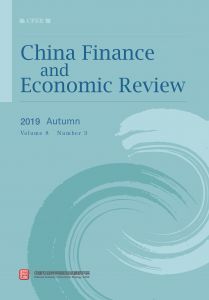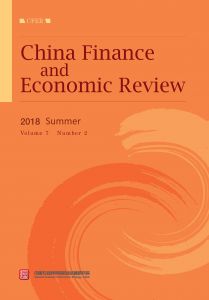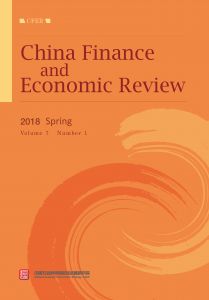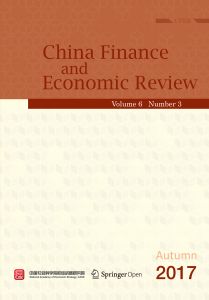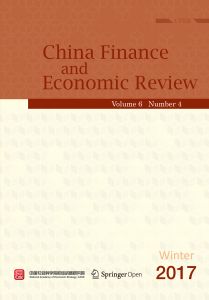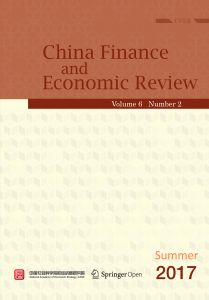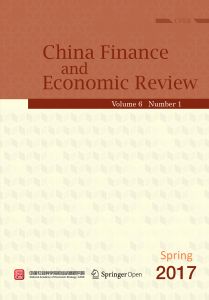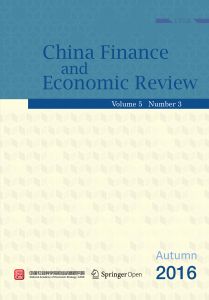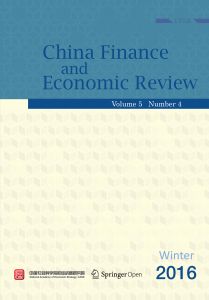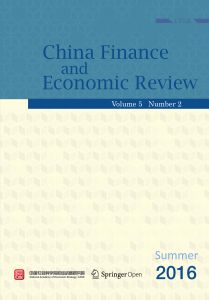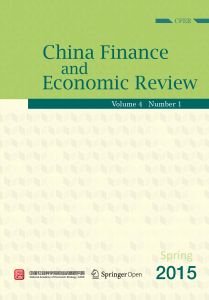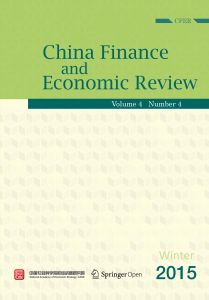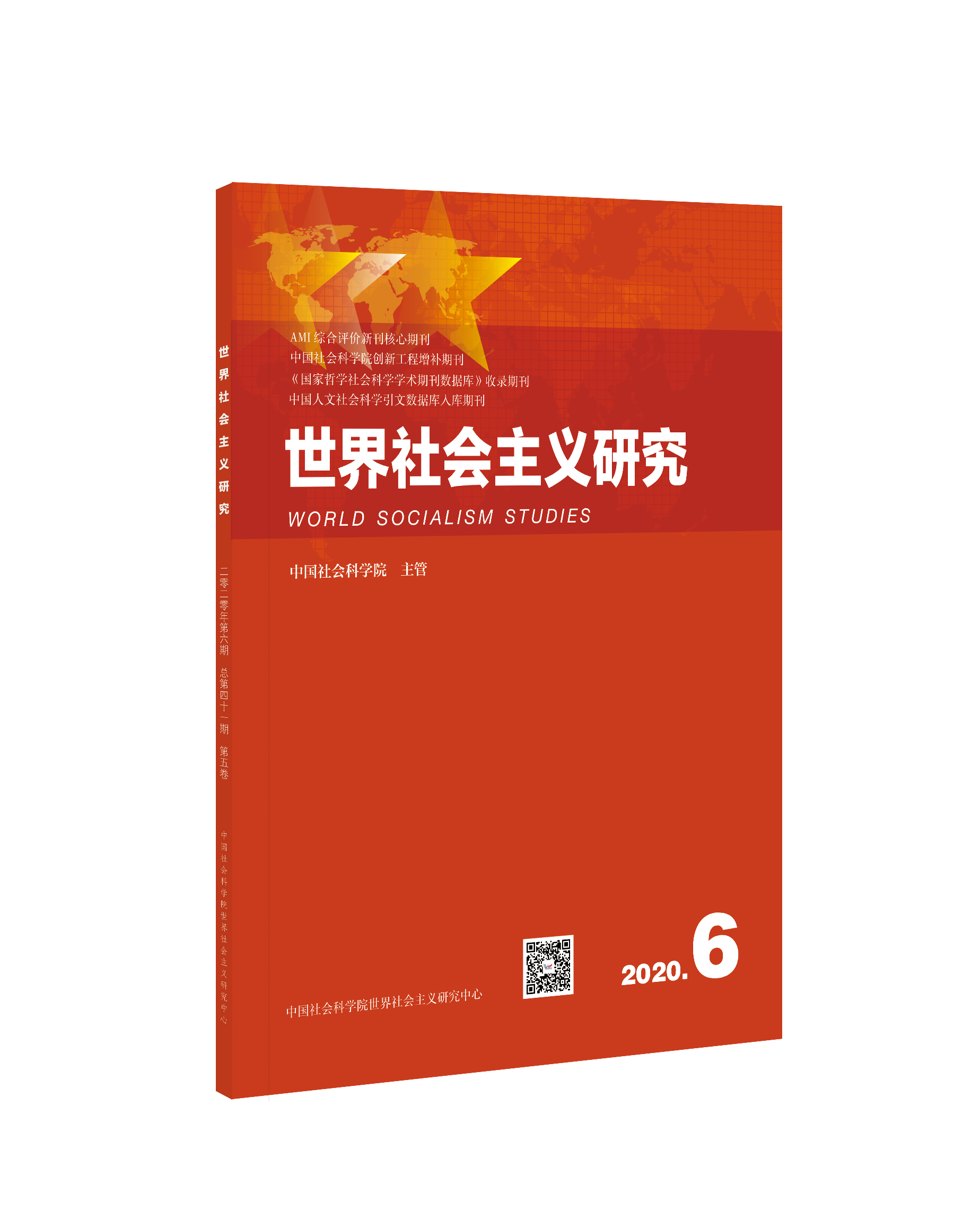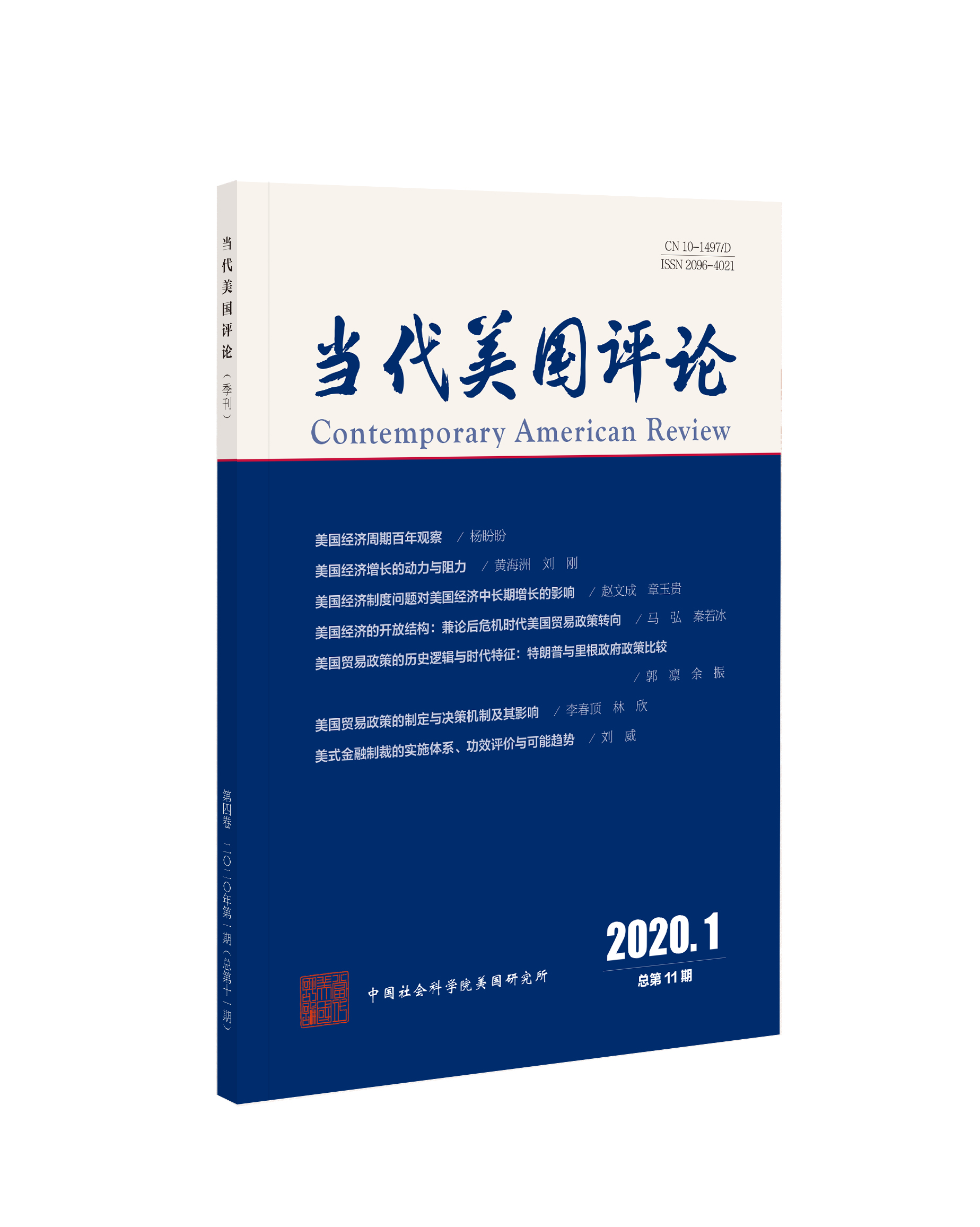最新期刊
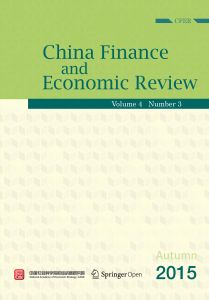
目录
过往期刊
参考文献
-
Instructions for Authors
-
编委会
-
On improving the statistical index system of the circulation industry in China
-
1. The definition of circulation statistics
-
2. Current statistical systems of circulation and setting of indicators
-
3. The existing problems of the current statistical systems and the setting of indicators of circulation in domestic trade
-
4. Suggestions on improving the statistical systems and the setting of indicators of the circulation in domestic trade
-
-
Comparative analysis of trade effects of anti-dumping measures targeting China vs. those initiated by China
-
1. Introduction
-
2. The situation and characteristics of anti-dumping measures targeting China and those initiated by China
-
3. The trade effect comparison of anti-dumping in either direction
-
4. Conclusions and policy recommendations
-
-
Institutional environment and risk of a stock price crash: evidence from China
-
1. Introduction
-
2. Theoretical analysis and research hypothesis
-
3. The research design
-
4. Analysis of empirical results
-
5. Expanding test
-
6. Conclusions
-
-
Evaluation of financial management reform in China since 1994
-
1. Background of financial management system reform
-
2. The definition of evaluation criteria of financial management system reform
-
3. The systematic evaluation of financial management system reform effect
-
4. Analysis of evaluation results
-
5. Outlook of the future financial management system
-
-
Restructuring and differentiated regulatory policies in China’s petroleum industry
-
1. Introduction
-
2. Measurements of monopoly and efficiency losses in China’s petroleum industry
-
3. Type analysis of monopolies in China’s petroleum industry
-
4. Market restructuring patterns of China’s petroleum industry
-
5. Differentiated regulatory policies following market restructuring of China’s petroleum industry
-
6. Research conclusions
-
-
A new broom sweeps clean: is there a Chinese-style political business cycle?
-
1. Introduction
-
2. Current explanations: fiscal decentralization and promotion tournament
-
3. A new explanation: the political cycle and the effects of personnel changes
-
4. The model, variables, and explanation of data
-
5. Empirical results and analysis
-
6. Conclusions and implications
-
按年份浏览:
- 全部
- 2020
- 2019
- 2018
- 2017
- 2016
- 2015
- 2014
- 2013
[1][1]Bao, X. H. (2007). The trade remedy effect of anti-dumping policies. Economic Research Journal (Jingji Yanjiu) , 2, 71-84.
[2][2]Chad, P. B. (2008). The WTO and antidumping in developing countries. Economics and Politics , 20 (2), 255-288.
[3][3]Hai, W., & Li, Q. L. (2011). The practical analysis of anti-dumping in China in ten years since China’s accession into WTO. International Business Research (Guoji Shangwu Yanjiu) , 32 (3), 37-44.
[4][4]Lall, S. (2000). The technological structure and performance of developing country manufactured exports, 1985-1998. Oxford Development Studies , 28 (3), 337-369.
[5][5]Li, C. D. (2007). Reverse thinking: analysis of positive effects of China’s foreign trade friction, International Business (Guoji Shangwu) , 3, 5-10.
[6][6]Li, C. D., Shi, X. J., & Fei, T. A. (2013). Production promotion effect of passive anti-dumping: evidence and interpretation, Finance and Trade Economics (Caimao Jingji) , 7, 68-78.
[7][7]Prusa, T. J. (2005). Anti-dumping: a growing problem in international trade. The World Economy, 28 (5), 683-700.
[8][8]Qi, J. Y. (2006). Comparative analysis of the indexes for anti-dumping measures in either direction. Finance and Trade Research (Caimao Yanjiu) , 1, 37-41.
[9][9]Qi, J. Y. (2010). Symmetric comparative analysis of anti-dumping in China and India. Finance and Trade Economics (Caimao Jingji) , 5, 82-88.
[10][10]Shen, G. B. (2012). The dominant comparative advantage and trade effect of anti-dumping on China from USA. World Economy (Shijie Jingji) , 12, 62-82.
[11][11]Su, Z. D., Liu, L. Y., & Hong, Y. J. (2012). Can externally directed anti-dumping improve performance of Chinese enterprises? Finance and Trade Economics (Caimao Jingji) , 3, 68-75.
[12][12]Van LE, T. T., & TONG, S. Y. (2009). China and anti-dumping: regulations, practices and responses. EAI Working Paper , 149.
[13][13]Yin, X. S., & Li, C. D. (2007). The north-south asymmetry of international trade friction and the form of friction—based on the analysis of a 3-countries trade model. Nankai Economic Studies (Nankai Jingji Yanjiu) , 5, 53-66.
[14][14]Ye, Z. Y. (2010). Re-calculation of capital stock in China. Statistics and Information Forum (Tongji Yu Xinxi Luntan) , 7, 36-41.
[15][15]Ball, R. (2009). Market and political/regulatory perspectives on the recent accounting scandals. Journal of Accounting Research , 47 (2), 277-323.
[16][16]Bushman, R., & J. Piotroski. (2006). Financial reporting incentives for conservative accounting: the influence of legal and political institutions. Journal of Accounting and Economics, 42 (1/2), 107-148.
[17][17]Bushman, R. M., J. D. Piotroski, & A. J. Smith. (2004). What determines corporate transparency? Journal of Accounting Research, 42 (2), 207-252.
[18][18]Chen, X. Y., Li, M. C., Rui, M., & Xia, L. J. (2009). Judicial independence and enforcement of investor protection law—the market reaction on the “Notice of 1/15” of Supreme People’s Court. China Economic Quarterly (Jingjixue Jikan) , 9 (1), 1-28.
[19][19]Cheng, X. S., Tan, Y. C., & Xu, L. (2011). Company value, volunteer disclosure and marketization process. Financial Research (Jinrong Yanjiu) , 8, 111-127.
[20][20]Dechow, P., Sloan, R. & A. Sweeney. (1995). Detecting earnings management. Accounting Review, 70 (2), 193-225.
[21][21]DeFond, M., & M. Hung. (2004). Investor protection and corporate governance: evidence from worldwide CEO turnover. Journal of Accounting Research, 42 (2), 269-312.
[22][22]Dimson, E. (1979). Risk measurement when shares are subject to infrequent trading. Journal of Financial Economics, 7 (2), 197-226.
[23][23]Dyck, A., L. Zingales. (2004). Private benefits of control: an international comparison. Journal of Finance, 59 (2), 537-600.
[24][24]Faccio, M. (2006). Politically connected firms. American Economic Review, 96 (1), 369-386.
[25][25]Fan, G., Wang, X. L., & Zhu, H. P. (2011). China’s marketization index---relative progress of the regional marketization in 2011 . Beijing: Economic Science Press.
[26][26]Fan, J. P. H., T. J. Wong, & T. Zhang. (2013). Institutions and organizational structure: the case of state-owned corporate pyramids. Journal of Law, Economics, and Organization, 29 (6), 1217-1252.
[27][27]Fang, J. X. (2006). The process of marketization and improvement of capital allocation efficiency. Economic Research Journal (Jingji Yanjiu) , 5, 50-61.
[28][28]Fang, J. X. (2007). Ownership, institutional environment and credit capital allocation. Economic Research Journal (Jingji Yanjiu) ,12, 82-92.
[29][29]Filip, A., R. Labelle, & S. Rousseau. (2015). Legal regime and financial reporting quality. Contemporary Accounting Research, 32 (1), 280-307.
[30][30]Gul, F.A., J-B. Kim, & A. A. Qiu. (2010). Ownership concentration, foreign shareholding, audit quality, and stock price synchronicity: evidence from China. Journal of Financial Economics, 95 (3), 425-442.
[31][31]Hutton, A.P., A.J. Marcus, & H. Tehranian. (2009). Opaque financial reports, R2, and crash risk. Journal of Financial Economics, 94 (1), 67-86.
[32][32]Jiang, F. X., & Huang, J. C. (2011). Marketization process and dynamic adjustment of capital structure. Management World (Guanli Shijie) , 3, 124-134.
[33][33]Jiang, Y. B., & Yang, T. (2012). The impact of institutional environment on the implementation of accounting standards. Accounting Research (Kuaiji Yanjiu) , 4, 69-78.
[34][34]Jin, L., & C.S. Myers. (2006). R2 around the world: new theory and new tests. Journal of Financial Economics , 79 (2), 257-292.
[35][35]Kim J.-B., Y. Li, & L. Zhang. (2011a). Corporate tax avoidance and stock price crash risk: firm-level analysis. Journal of Financial Economics, 100 (3), 639-662.
[36][36]Kim J.-B., Y. Li, & L. Zhang. (2011b). CFOs versus CEOs: equity incentives and crashes. Journal of Financial Economics , 101 (3), 713-730.
[37][37]Kim, J.B., & L. Zhang. (2015). Accounting conservatism and stock price crash risk: firm-level evidence. Contemporary Accounting Research , doi: 10.1111/1911-3846.12112.
[38][38]Kornail, J., E. Maskin, & Roland, G. (2003). Understanding the soft budget constraint. Journal of Economic Literature, 41 (4), 1095-1136.
[39][39]Kothari, S.P., Shu, S. & Wysocki, P. D. (2009). Do managers withhold bad news? Journal of Accounting Research , 47 (1), 241-276.
[40][40]La Porta, R., F. Lopez-de-Silanes, A. Shleifer, & R. Vishny. (2000). Investor protection and corporate governance. Journal of Financial Economics , 58 (1), 3-27.
[41][41]LaPorta, R., F. Lopez-de-Silanes, A. Shleifer, & R.Vishny. (1998). Law and finance. Journal of Political Economy , 106, 1113-1155.
[42][42]La Porta, R., F. Lopez-de-Silanes, A. Shleifer, & R. Vishny. (1997). Legal determinants of external finance. Journal of Finance , 52 (3), 1131-1150.
[43][43]La Porta, R., F. Lopez-de-Silanes, & A. Shleifer. (1999). Corporate ownership around the world. Journal of Finance , 54, 471-517.
[44][44]Lei, G. Y., & Liu, H. L., Marketization process, the nature of ultimate controller and cash dividend behavior. Management World (Guanli Shijie), 7, 120-128.
[45][45]Li, X. R., & Liu, H. (2012). CEO vs CFO: sex and stock price crash risk. World Economy (Shijie Jingji ), 12, 102-129.
[46][46]Li, X. L., Zhang, X., Liu, Z., & Chen, D. (2012). Institutional environment and rent-seeking activities: research with the data from World Bank. China Industrial Economics (Zhongguo Gongye Jingji) , 11, 84-96.
[47][47]Lin, Y. F., & Li, Z. Y. (2004). Policy burden, moral hazard and soft budget constraint. Economic Research Journal (Jingji Yanjiu ), 2, 17-27.
[48][48]Luo, D. L., & Tang, Q. Q. (2009). Research on institutional environment and performance of private listed corporations in China. Economic Research Journal (Jingji Yanjiu) , 2, 106-118.
[49][49]Morck, R., B. Yeung, & W. Yu. (2000). The information content of stock markets: why do emerging markets have synchronous stock price movements? Journal of Financial Economics, 58 (1-2), 215-260.
[50][50]Pan, H. B., & Yu, M. G. (2011). Support hand, grabbing hand and remote acquisition. Economic Research Journal (Jingji Yanjiu) , 9, 108-120.
[51][51]Piotroski, J. D., & T.J. Wong. (2011). Institutions and information environment of Chinese listed firms. Working Paper, The Chinese University of Hong Kong.
[52][52]Piotroski, J.D., T.J. Wong, & T. Zhang. (2011). Political incentives to suppress negative financial information: evidence from state-controlled Chinese firms. Working Paper, The Chinese University of Hong Kong.
[53][53]Sun, Z., Liu, F. W., & Li, Z. Q. (2005). Marketization degree, government intervention and corporate debt maturity structure—empirical evidence from China’s listed companies. Economic Research Journal (Jingji Yanjiu) , 5, 52-63.
[54][54]Tang, X. S., Luo, S., & Wang, H. Y. Marketization process and the role of government audit. Audit Research (Shenji Yanjiu) , 3, 25-31.
[55][55]Teng, T., Wang, G. P., & Liu, Z. (2008). Spike model vs correct investment philosophy. Topic research report from the Galaxy Securities Institution.
[56][56]Xia, L. J., & Chen, X. Y. (2007). Marketization process, reform strategy of state-owned enterprises and endogenous decision of corporate governance structure. Economic Research Journal (Jingji Yanjiu) , 7, 82-95.
[57][57]Xia, L. J., Fang, Y. Q. (2005). Government controlling, governance environment and company value—empirical evidence from security market of China. Economic Research Journal (Jingji Yanjiu) , 5, 40-51.
[58][58]Xu, N. X., Jiang, X. Y, Yi, Z. H., & Xu, X. Z. (2012). Interests conflict of analyst, optimistic bias and stock price crash. Economic Research Journal (Jingji Yanjiu) , 7, 127-140.
[59][59]Xu, N. X., Hong, T., Wu, S. N., & Xu, X. Z. (2011). Information transfer model, investors’ psychological bias and stock price’s synchronous fall and rise. Economic Research Journal (Jingji Yanjiu) , 4, 135-146.
[60][60]Xu, N. X., Yu, S. Y., Yi, Z. Z. (2013). The herding behavior of institutional investors and stock price crash risk. Management World (Guanli Shijie) , 7, 31-43.
[61][61]Williamson, O.E. (1975). Markets and hierarchies, analysis and antitrust implications . London: Collier Macmillan Publishing.
[62][62]Yan, W., Xu, R., Shi, Q. H., & Wang, Y. X. (2012). Property rights protection and market information asymmetry: evidence from China A-B share. Economic Research Journal (Jingji Yanjiu) , 12, 128-141.
[63][63]Yu, H. L. (2006). Government controlling and efficiency of governance mechanism----based on the empirical evidence from China’s A-share market. Nankai Business Review (Nankai Guanli Pinglun) , 9 (1), 98-102.
[64][64]Zheng, G. J. (2011). The micro mechanism of market reform: from the perspective of related party transaction. China Accounting Review (Zhongguo Kuaiji Pinglun) , 9 (3), 337-352.
[65][65]Zhou, W., Xu, Y. D., & Li, H. Y. (2011). Network of relationship between government and enterprise, perquisite consumption and market system construction. Statistical Research (Tongji Yanjiu) , 2, 53-58.
[66][66]Helm, D. (2004). Energy, the state and the market: British energy policy since 1979, Oxford, UK: Oxford University Press.
[67][67]Hu, D. B., & Lin, N. (2013). Measurement of welfare losses in China’s petroleum industry: from the perspective of relaxing regulation. Review of Industrial Economics (Chanye Jingji Pinglun) , 12 (4), 155-168.
[68][68]Jin, Y., Chen, Z., & Lu, M. (2006). Industry agglomeration in China: economic geography, new economic geography and policy. Economic Research Journal (Jingji Yanjiu) , 4, 79-89.
[69][69]Laguna, N. M. (2004). Petroleum policies and privatization strategies in Mexico: implications for the petrochemical sector and its production spaces. Energy Policy , 32 (18), 2035-2047.
[70][70]Li, Z. G., Guo, J. G., & Zhou, D. T. (2012). An empirical study on administrative monopoly of China’s petroleum industry and its performance. Contemporary Finance and Economics (Dangdai Caijing) , 6, 89-101.
[71][71]Locatelli, C. (1999). The Russian petroleum industry restructuration: towards the emergency of western type enterprises? Energy Policy, 27 (8), 435-449.
[72][72]Robinson, C. (2000). Energy economics and economic liberalism. Energy Journal , 21 (2), 1-22.
[73][73]Straaten, J.V. (2001). Petroleum refineries in the Netherlands . Berlin: Springer Berlin Heidelberg.
[74][74]Wang, J. H. (2005). Differentiated regulation and coordinated policies after market restructuring of China’s monopoly industries. China’s Industrial Economics (Zhongguo Gongye Jingji) , 11, 67-73.
[75][75]Wang, J. H., & Wang, J. M. (2007). Administrative monopoly of China’s monopoly industries and its regulation policies. China’s Industrial Economics (Zhongguo Gongye Jingji) , 12, 30-37.
[76][76]Weston, J. F., Johnson, B. A., & Siu, J. A. (1999). Mergers and restructuring in the world petroleum industry. Journal of Energy Finance & Development , 4 (2), 149-183.
[77][77]Yan, X. Z., Yu, Z. H., & Cong, Q. (2014). The extent of oligopoly and market competition in petroleum industry, International Petroleum Economics (Guoji Shiyou Jingji) , 22, 1-8.
[78][78]Young, A. (2000). The razor’s edge: distortions and incremental reform in the People’s Republic of China. The Quarterly Journal of Economics , 115 (4), 1091-1135.
[79][79]Yu, X. Z., Liu, H. Y. & Wang, J. (2009). A study on operating efficiency of oligopoly in petroleum industry. Reform of Economic System (Jingji Tizhi Gaige) , 6, 71-75.
[80][80]Yu, X. Z., & Zhong, C. B. (2010). Vertical comparison analysis of operating efficiency of monopoly of state prices petroleum resources. Inquiry into Economic Issues (Jingji Wenti Tansuo) , 1, 68-74.
[81][81]Yu, L. C, & Zhang, W. (2010). Intensity and efficiency loss of administrative monopoly industry in China. Economic Research Journal (Jingji Yanjiu) , 3, 16-27.
[82][82]Zhang, X. Y., & Zhang, G. Z. (2013). Privatization appears in Mexico. China Petroleum (Zhongguo Shiyou Shihua) , 8, 56-57.
[83][83]Zhang, Y. H., & Li, X. S. (2008). Administrative monopoly, relaxing regulation and industrial performance—an empirical analysis based on petroleum exploration and exploitation. Contemporary Finance and Economics (Dangdai Caijing) , 2, 80-86.
[84][84]Alesina, A., Roubini, N. & Cohen, D. (1997). Political cycles and the macro-economy. Cambridge: MIT Press.
[85][85]Arellano, M. & Bover, O. (1995). Another look at the instrumental variable estimation of error-components models. Journal of Econometrics , 68 (1), 29-51.
[86][86]Bai, C. E., Du, Y. J., Tao, Z. G., & Tong, Y. T. (2004). local protectionism, determinants and changes of the regional industry concentration. Economic Research Journal (Jingji Yanjiu) , 4, 29-40.
[87][87]Blundell, R. & Bond, S. (1998). Initial conditions and moment restrictions in dynamic panel data models. Journal of Econometrics , 87 (1), 115-143.
[88][88]Brennan, G. & Pincus J. (1996). A minimalist model of federal grants and flypaper effects. Journal of Public Economics , 61 (2), 229-246.
[89][89]Chen, K., Hillman, A. L., & Gu, Q. Y. (2002). Fiscal centralization and the changes of local government behavior—from the helping hand to the grabbing hand. China Economic Quarterly (Jingjixue Jikan ), 2 (1), 111-130.
[90][90]Chen, G., Li, S., & Yu, J. S. (2009). Helping hand or grabbing hand? The hypothesis and verification about the Chinese-style decentralization. South China Journal of Economics (Nanfang Jingji) , 7, 3-15.
[91][91]Cao, Y. S., Lou, D. W. (2012). Resources mismatch, structural changes and transition of Chinese economy. China Industrial Economy (Zhongguo Gongye Jingji) , 10, 5-18.
[92][92]Chen, W. D., Miao, W. L. (2010). Government rotation, economic policy and political-economic cycle. Economic Survey (Jingji Jingwei) , 4, 14-19.
[93][93]Fang, H. S., Zhang, J. (2013). Grabbing hand, helping hand and growth rate of Chinese tax surpassing GDP growth rate. Economic Research Journal (Jingji Yanjiu) ,3, 108-121.
[94][94]Fang, H. S., Zhang, J. (2014). The reevaluation of financial centralization’s incentive effect: grabbing hand or helping hand. Management World (Guanli Shijie) , 2, 21-31.
[95][95]Fan, Z. Y. (2013). Transfer payments, infrastructure investments and corruption. Comparative Economic & Social System (Jingji Shehui Tizhi Bijiao) , 2, 179-192.
[96][96]Fu, Y., & Zhang, Y. (2007). The structure bias of Chinese-style decentralization and fiscal expenditure. Management World (Guanli Shijie) , 3, 4-12.
[97][97]Guo, Q. W., & Jia, J. X. (2006). Local government behavior, impulsive investment and macroeconomic stability. Management World (Guanli Shijie) , 5, 19-25.
[98][98]Gong, Q., Wang, J., Jia, K. (2011). A study of local government debt from the perspective of fiscal decentralization: a review. Economic Research Journal (Jingji Yanjiu) , 7, 144-156.
[99][99]Gu, Y. Y., & Shen, K. R. (2012). Local government behavior and R&D investment of enterprises. China Industrial Economy (Zhongguo Gongye Jingji) , 10, 77-88.
[100][100]Hibbs, A. (1977). Political parties and macroeconomic policy. American Political Science Review, 71 (4), 1467-1487.
[101][101]Jia, J. X., Guo, Q. W., & Zhao, X. J. (2012). The cyclical characteristic of local government expenditure behavior and its institutional roots. Management World (Guanli Shijie) , 2, 7-18.
[102][102]Jiang, F. X., & Lin, J. (2010). Promotion tournament, finance cyclical and economic fluctuations—since China’s reform and opening up. Finance and Trade Economics (Caimao Jingji) , 7, 44-50.
[103][103]Kiviet, F. (1995). On bias, inconsistency and efficiency of various estimators in dynamic panel data models. Journal of Econometrics , 68 (1), 53-78.
[104][104]Kiviet, F. (2012). Monte Carlo simulation for econometricians. Boston: Now Publishers.
[105][105]Li, H. B. & Zhou, L. A. (2005). Political turnover and economic performance. Journal of Public Economics , 89 (10), 1743-1762.
[106][106]Li, M., & Shen, K. R. (2010). The impact of local government behavior on China’s economic fluctuations. Economic Research Journal (Jingji Yanjiu) , 12, 35-47.
[107][107]Liu, X. H. (2004). Why China’s economy is overheating or overcooling. Economic Research Journal (Jingji Yanjiu) , 11, 58-68.
[108][108]Lin, Y. F., Cai, F., & Li, Z. (1999). China’s miracle: development strategy and economic reform . Shanghai: People’s Publishing House. (In Chinese)
[109][109]Lu, M., & Chen, Z. (2009). Economic growth in the split market—why economic liberalization can exacerbate local protection. Economic Research Journal (Jingji Yanjiu) , 3, 42-52.
[110][110]Liu, R. M. (2007). Promotion incentives, industry isomorphism and local protection: an explanation on the basis of the political control right’s benefits. South China Journal of Economics (Nanfang Jingji) , 6, 61-72.
[111][111]Nie, H. H., Jiang, M. & Wang, X. (2013). The impact of political cycle: evidence from coalmine accidents in China. Journal of Comparative Economics , 41 (4), 995-1011.
[112][112]Nordhaus, D. (1975). The political business cycle. Review of Economic Studies, 42 (2), 169-190.
[113][113]Persson, T., & Tabellini, G., The size and scope of government: comparative politics with rational politicians. European Economic Review , 43 (4/6), 699-735.
[114][114]Qiu, H. X., & Xu, J. N. (2004). The local government behavior in the industrial cluster innovation. Management World (Guanli Shijie) , 10, 36-46.
[115][115]Qiao, Y. B., Fan, J. Y., & Feng, X. Y. (2005). The fiscal decentralization in China and the compulsory primary education. Chinese Social Science (Zhongguo Shehui Kexue) , 6, 37-46.
[116][116]Rogoff, K. (1990). Equilibrium political budget cycles. American Economic Review , 80 (1), 21-36.
[117][117]Roodman, D. (2009). How to do xtabond2: an introduction to difference and system GMM in stata. The Stata Journal , 9 (1), 86-136.
[118][118]Rodden, J. & Wibbles, Erik. (2002). Beyond the fiction of federalism: macroeconomic management in multitiered systems, World Politic , 54 (7), 494-531.
[119][119]Song, Z., Storesletten, K. & Zilibotti, F. (2011). Growing like China. American Economic Review , 101 (1), 202-241.
[120][120]Tao, R., Su, F. B., Lu, X., & Zhu, Y. M. (2010). Can economic growth bring the promotion?—on the basis of the logic challenges of the promotion tournament theory and revaluation of the provincial empirical. Management World (Guanli Shijie) , 12, 13-26.
[121][121]Wang, X. B., Zhang, L, & Xu, X. X. (2011). The economic performance in the area and the promotion of governor provincial secretary. Comparative Economic & Social System (Jingji Shehui Tizhi Bijiao) , 1, 110-122.
[122][122]Wang, Y. W., Wang, J. H. (2009). The theory and empirical analysis of local government and convergence of local industrial structure. Nankai Economic Studies (Nankai Jingji Yanjiu) , 4, 33-49.
[123][123]Wang, W. J., Qin, C. L. (2008). Llocal government behavior and the regional difference of fiscal decentralization growth effect. Management World (Guanli Shijie) , 1, 9-21.
[124][124]Windmeijer, F. (2005). A finite sample correction for the variance of linear efficient two-step GMM estimators. Journal of Econometrics , 126 (1), 25-51.
[125][125]Wu, Y. P. (2008). Fiscal decentralization, corruption and governance, China Economic Quarterly (Jingjixue Jikan) , 3, 1045-1060.
[126][126]Wen, Y. B. (2014). Chinese local government behavior choices and evolution from the perspective of regional heterogeneity, China Population Science (Zhongguo Renkou Kexue) , 3, 66-76.
[127][127]Yang, Q. J., Zheng, N. (2013). Is the promotion competition the ruler competition, championship or qualifier? World Economy (Shijie Jingji) , 12, 130-156.
[128][128]Zhang, Y., Gong, L. T. (2005). Tax reform, fiscal decentralization and Chinese economic growth, China Economic Quarterly (Jingjixue Jikan) , 1, 75-108.
[129][129]Zhang, G. (2011). Measuring China’s fiscal decentralization. Comparative Economic & Social System (Jingji Shehui Tizhi Bijiao) , 6, 48-61.
[130][130]Zhang, J. (2005). Competition for growth: an interpretation of a Chinese mystery. Donyue Tribune (Dongyue Luncong) , 4, 15-19.
[131][131]Zhang, J., Gao, Y., Fu, Y., & Zhang, H. (2007). Why China has a good infrastructure? Economic Research Journal (Jingji Yanjiu) , 3, 4-19.
[132][132]Zhou, L. A. (2007). The study on the model of promotion tournament of local officials. Economic Research Journal (Jingji Yanjiu) , 7, 36-50.
[133][133]Zhou, L. A., Zhao, Y. Y., & Li, L. X. (2013). Resource mismatch and political cycle. Financial Research (Jinrong Yanjiu) , 3, 15-29.
[展开]
相关推荐
手机可扫码阅读


